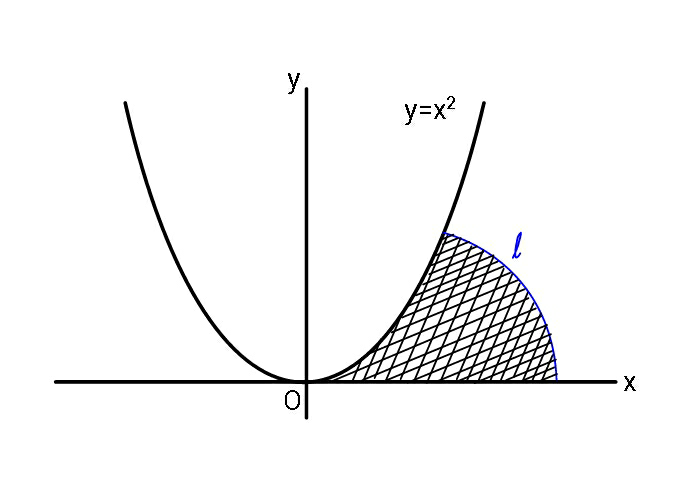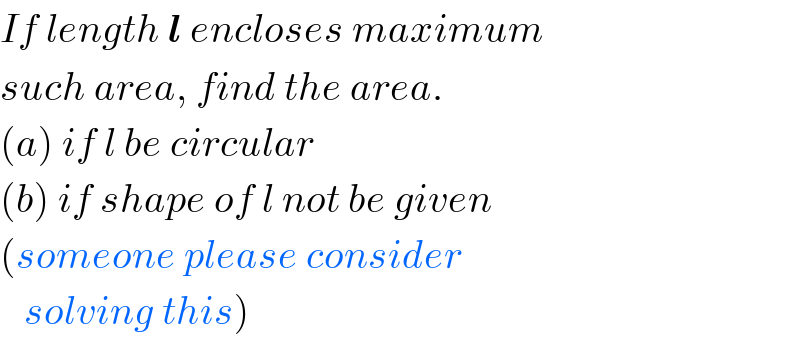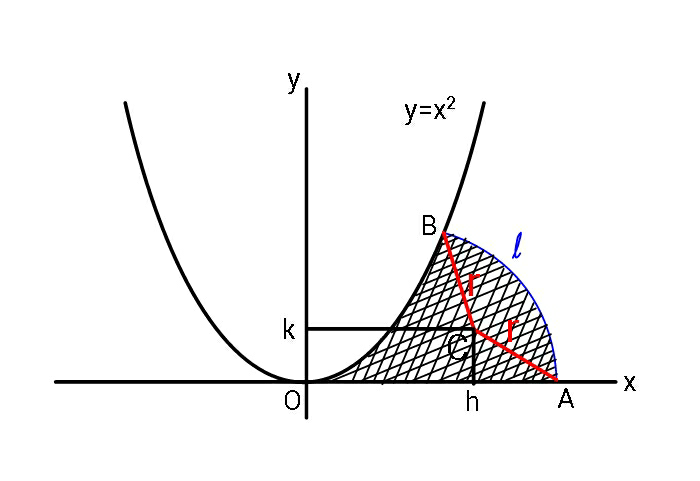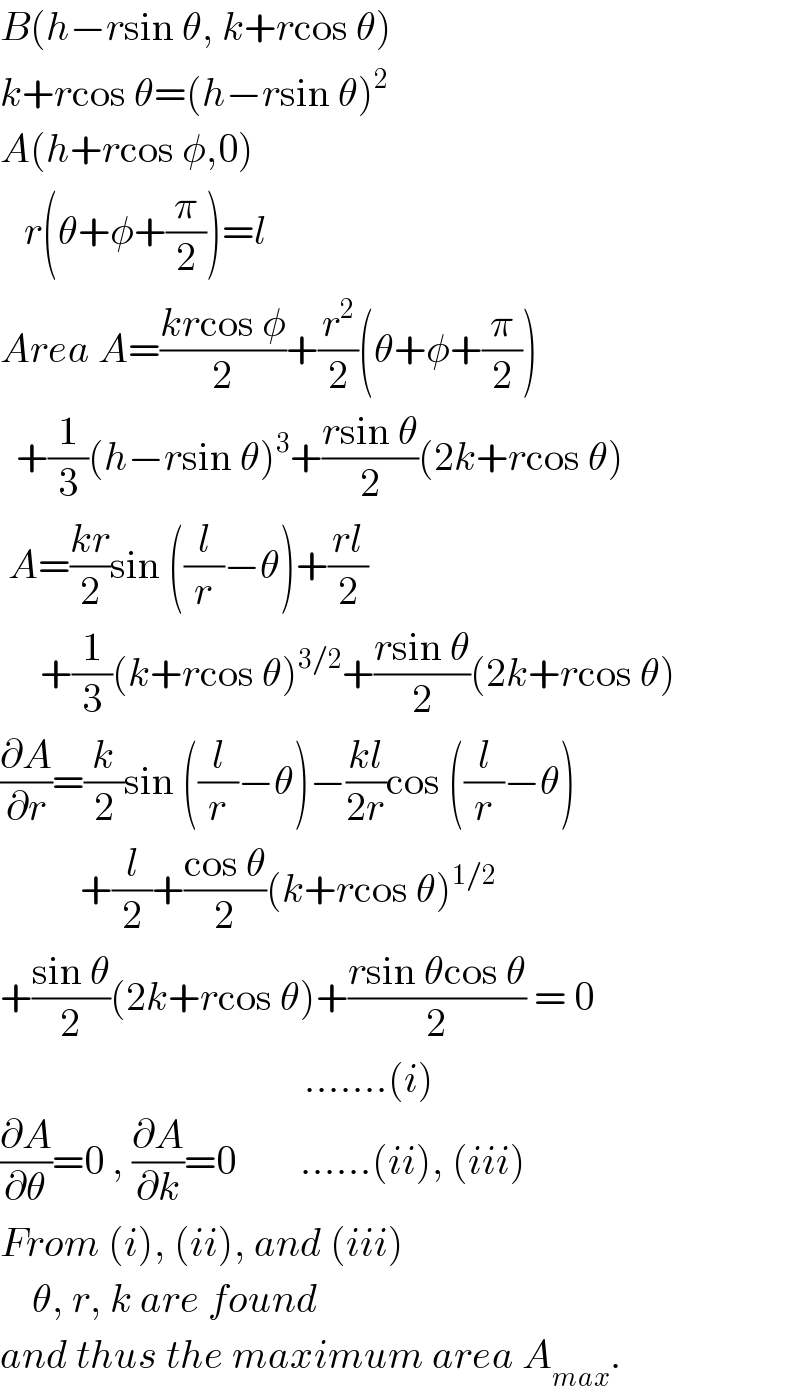
Question Number 60888 by ajfour last updated on 26/May/19

Commented by ajfour last updated on 27/May/19

$${If}\:{length}\:\boldsymbol{{l}}\:{encloses}\:{maximum} \\ $$$${such}\:{area},\:{find}\:{the}\:{area}. \\ $$$$\left({a}\right)\:{if}\:{l}\:{be}\:{circular} \\ $$$$\left({b}\right)\:{if}\:{shape}\:{of}\:{l}\:{not}\:{be}\:{given} \\ $$$$\left({someone}\:{please}\:{consider}\right. \\ $$$$\left.\:\:\:{solving}\:{this}\right) \\ $$
Answered by ajfour last updated on 26/May/19

Commented by ajfour last updated on 27/May/19

$${B}\left({h}−{r}\mathrm{sin}\:\theta,\:{k}+{r}\mathrm{cos}\:\theta\right) \\ $$$${k}+{r}\mathrm{cos}\:\theta=\left({h}−{r}\mathrm{sin}\:\theta\right)^{\mathrm{2}} \\ $$$${A}\left({h}+{r}\mathrm{cos}\:\phi,\mathrm{0}\right) \\ $$$$\:\:\:{r}\left(\theta+\phi+\frac{\pi}{\mathrm{2}}\right)={l} \\ $$$${Area}\:{A}=\frac{{kr}\mathrm{cos}\:\phi}{\mathrm{2}}+\frac{{r}^{\mathrm{2}} }{\mathrm{2}}\left(\theta+\phi+\frac{\pi}{\mathrm{2}}\right) \\ $$$$\:\:+\frac{\mathrm{1}}{\mathrm{3}}\left({h}−{r}\mathrm{sin}\:\theta\right)^{\mathrm{3}} +\frac{{r}\mathrm{sin}\:\theta}{\mathrm{2}}\left(\mathrm{2}{k}+{r}\mathrm{cos}\:\theta\right) \\ $$$$\:{A}=\frac{{kr}}{\mathrm{2}}\mathrm{sin}\:\left(\frac{{l}}{{r}}−\theta\right)+\frac{{rl}}{\mathrm{2}} \\ $$$$\:\:\:\:\:+\frac{\mathrm{1}}{\mathrm{3}}\left({k}+{r}\mathrm{cos}\:\theta\right)^{\mathrm{3}/\mathrm{2}} +\frac{{r}\mathrm{sin}\:\theta}{\mathrm{2}}\left(\mathrm{2}{k}+{r}\mathrm{cos}\:\theta\right) \\ $$$$\frac{\partial{A}}{\partial{r}}=\frac{{k}}{\mathrm{2}}\mathrm{sin}\:\left(\frac{{l}}{{r}}−\theta\right)−\frac{{kl}}{\mathrm{2}{r}}\mathrm{cos}\:\left(\frac{{l}}{{r}}−\theta\right) \\ $$$$\:\:\:\:\:\:\:\:\:\:+\frac{{l}}{\mathrm{2}}+\frac{\mathrm{cos}\:\theta}{\mathrm{2}}\left({k}+{r}\mathrm{cos}\:\theta\right)^{\mathrm{1}/\mathrm{2}} \\ $$$$+\frac{\mathrm{sin}\:\theta}{\mathrm{2}}\left(\mathrm{2}{k}+{r}\mathrm{cos}\:\theta\right)+\frac{{r}\mathrm{sin}\:\theta\mathrm{cos}\:\theta}{\mathrm{2}}\:=\:\mathrm{0} \\ $$$$\:\:\:\:\:\:\:\:\:\:\:\:\:\:\:\:\:\:\:\:\:\:\:\:\:\:\:\:\:\:\:\:\:\:\:\:\:\:.......\left({i}\right) \\ $$$$\frac{\partial{A}}{\partial\theta}=\mathrm{0}\:,\:\frac{\partial{A}}{\partial{k}}=\mathrm{0}\:\:\:\:\:\:\:\:......\left({ii}\right),\:\left({iii}\right) \\ $$$${From}\:\left({i}\right),\:\left({ii}\right),\:{and}\:\left({iii}\right) \\ $$$$\:\:\:\:\theta,\:{r},\:{k}\:{are}\:{found} \\ $$$${and}\:{thus}\:{the}\:{maximum}\:{area}\:{A}_{{max}} . \\ $$
